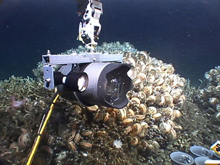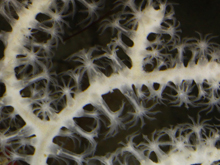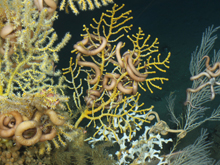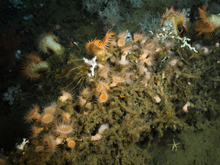
The latest deep-sea camera system uses a Canon SLR with light-emitting diode (LED) flood lamps in a "hand-held" mounting. The housing is titanium with a domed optical port. Click image for larger view and image credit.
This segment of a much larger image shows the eight tentacles that are diagnostic of an octocoral. The tiny polyps are often damaged during collection. Click image for larger view and image credit.
Imaging the Deep Sea
September 4, 2009
Ian MacDonald
Florida State University
The habitat of deep-sea corals has very little light other that what the remotely operated vehicle (ROV) Jason can carry with it. So images brought back from this realm are genuinely unique. Not only do people get to see these sites and their inhabitants for the first time, but no creature has ever seen them in the way we can now. The colors and tiny details are not visible to any fish or crustacean. As a scientist working in the deep sea for years now, I still feel a great sense of anticipation and excitement as the bottom comes into view at the beginning of a dive. It is like sitting in a theater waiting to see a movie or performance that you have really been looking forward to. The theater is dark and boring, but then the lights come up and the story begins.
Although we collect many types of data in an expedition like this one, images are a common thread in much of what we do. Digital pictures document the expedition, the participants, their equipment, the seafloor sites, and the samples collected. In some cases, the images are the data. One of my functions on this expedition is to get pictures that push science by showing aspects of deep-sea corals and their habitat that were previously unknown. For example, a detailed picture can resolve whether a specimen is an octocoral or an anthozoan. Or, it can show interactions between species that we would otherwise only guess about.
Another goal is to develop reliable keys to the species of hard and soft corals that will let scientists identify specimens from photographs without the need for collection. This expedition is particularly productive in that area because we are getting to take high-resolution pictures of a large number of specimens that are collected for molecular genetics and other taxonomic analyses.
On previous Ocean Exploration expeditions, I have used prosumer-grade digital cameras and lighting systems to make images in the 3-megapixel range. For Lophelia II, I developed a new deep-sea camera in collaboration with TDI-Brooks International ![]()
![]() and AquaPix
and AquaPix ![]()
![]() . It takes 15-megapixel images on a CMOS chip. This system uses the latest Canon EOS T1i
. It takes 15-megapixel images on a CMOS chip. This system uses the latest Canon EOS T1i ![]()
![]() camera in a titanium housing with a domed view-port. For optimum optical quality, I have elected to use fixed-focus rather than zoom lenses. On this cruise we are shooting with Canon EFS 60 mm macro and EF 20 mm wide-angle lenses. Lighting comes from a pair of ROS Brightlight LED
camera in a titanium housing with a domed view-port. For optimum optical quality, I have elected to use fixed-focus rather than zoom lenses. On this cruise we are shooting with Canon EFS 60 mm macro and EF 20 mm wide-angle lenses. Lighting comes from a pair of ROS Brightlight LED ![]()
![]() lamps that deliver the halogen equivalent of 500 watts at 5500 Kelvin, while only drawing 60 watts of power. The lamps are attached to the camera housing on a cross-bar with a T-handle that lets Jason aim and position the camera for precise compositions. The beauty of this simple system is that the lights illuminate whatever the camera is aimed at. Auto-focus takes care of the focal adjustments.
lamps that deliver the halogen equivalent of 500 watts at 5500 Kelvin, while only drawing 60 watts of power. The lamps are attached to the camera housing on a cross-bar with a T-handle that lets Jason aim and position the camera for precise compositions. The beauty of this simple system is that the lights illuminate whatever the camera is aimed at. Auto-focus takes care of the focal adjustments.
The camera is controlled over an Ethernet connection from the ship and we get 15-megapixel images up the umbilical as soon as they are taken. Using Jason's manipulator arm as a tripod, and relying on the skill and patience of the pilots as we request tiny movements to adjust composition, we can do true macro photography in 1,000 m depths. When the session is over, we run to our laptops to see the pictures full-scale while Jason is still on the bottom. Getting to share this new vision of a little-known realm is a true joy for a scientist who is also a photographer.






























